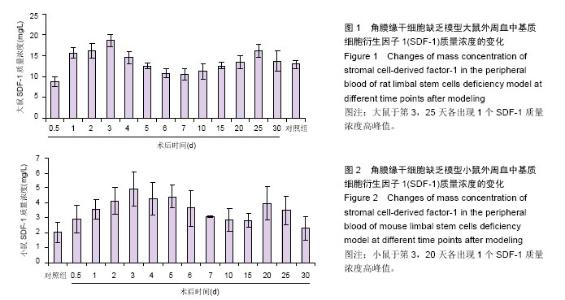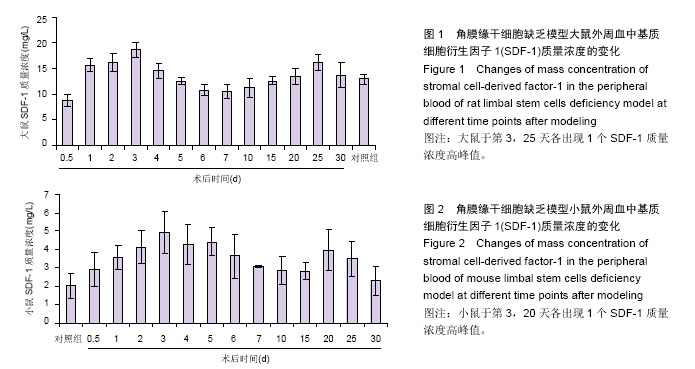Chinese Journal of Tissue Engineering Research ›› 2016, Vol. 20 ›› Issue (19): 2844-2849.doi: 10.3969/j.issn.2095-4344.2016.19.016
Previous Articles Next Articles
Variation of stromal cell-derived factor-1 level in a limbal stem cell deficiency model
Zhang Wei1, Huang Wen-zhi1, Zhang Yu-ping2
- 1Department of Geriatrics Ophthalmology, 2Department of Hematology, First People’s Hospital of Guangzhou, Guangzhou 510180, Guangdong Province, China
-
Received:2016-03-22Online:2016-05-06Published:2016-05-06 -
Contact:Zhang Yu-ping, M.D., Chief physician, Department of Hematology, First People’s Hospital of Guangzhou, Guangzhou 510180, Guangdong Province, China -
About author:Zhang Wei, M.D., Associate chief physician, Department of Geriatrics Ophthalmology, First People’s Hospital of Guangzhou, Guangzhou 510180, Guangdong Province, China -
Supported by:the National Natural Science Foundation of China, No. 81300733
CLC Number:
Cite this article
Zhang Wei, Huang Wen-zhi, Zhang Yu-ping. Variation of stromal cell-derived factor-1 level in a limbal stem cell deficiency model[J]. Chinese Journal of Tissue Engineering Research, 2016, 20(19): 2844-2849.
share this article

2.1 大鼠外周血中基质细胞衍生因子1水平变化 大鼠外周血中基质细胞衍生因子1质量浓度于术后24 h后出现显著性增高,于第3天达第1个高峰期,随后,血中基质细胞衍生因子1质量浓度逐渐降低,至第7天降至最低点后,又呈逐渐增高的趋势,至第25天又出现1个峰值,该峰值较第3天稍低,到30 d检测时质量浓度已恢复至接近正常数值,见图1。 2.2 小鼠外周血中基质细胞衍生因子1水平变化 小鼠外周血中基质细胞衍生因子1质量浓度于12 h后出现显著性增高,于第3天达第1个高峰期,随后,血中基质细胞衍生因子1的浓度逐渐降低,至第15天降至最低点后,又呈逐渐增高的趋势,至第20天又出现1个峰值,该峰值较第3天稍低,到30 d检测时质量浓度已恢复至接近正常数值,见图2。"

| [1] Gaharwar AK, Patel A, Dolatshahi-Pirouz A, et al. Elastomeric nanocomposite scaffolds made from poly (glycerol sebacate) chemically crosslinked with carbon nanotubes. Biomater Sci. 2015;3(1):45-68.[2] Pawar K, Cummings BJ, Thomas A, et al. Biomaterial bridges enable regeneration and re-entry of corticospinal tract axons into the caudal spinal cord after SCI: association with recovery of forelimb function. Biomaterials. 2015;65:1-12.[3] Siciliano C, Chimenti I, Ibrahim M, et al. Cardiosphere conditioned media influence the plasticity of human mediastinal adipose tissue-derived mesenchymal stem cells. Cell Transplant. 2015;24(11):2307-2322. [4] Li Y, Tang J, Hu Y, et al. A study of autologous stem cells therapy assisted regeneration of cartilage in avascular bone necrosis. Eur Rev Med Pharmacol Sci. 2015;19(20):3833-3837.[5] Selle F, Pautier P, Lhommé C, et al. A Phase I Trial of High-Dose Chemotherapy Combining Topotecan plus Cyclophosphamide with Hematopoietic Stem Cell Transplantation for Ovarian Cancer: the ITOV 01bis Study. Chemotherapy. 2015;61(1):15-22. [6] Richter R, Rüster B, Bistrian R, et al. Beta-chemokine CCL15 affects the adhesion and migration of hematopoietic progenitor cells. Transfus Med Hemother. 2015;42(1):29-37. [7] He H, Zhao ZH, Han FS, et al. Activation of protein kinase C ε enhanced movement ability and paracrine function of rat bone marrow mesenchymal stem cells partly at least independent of SDF-1/CXCR4 axis and PI3K/AKT pathway. Int J Clin Exp Med. 2015;8(1): 188-202. [8] Adamiak M, Borkowska S, Wysoczynski M, et al. Evidence for the involvement of sphingosine- 1-phosphate in the homing and engraftment of hematopoietic stem cells to bone marrow. Oncotarget. 2015;6(22):18819-18828.[9] Li N, Yang YJ, Qian HY, et al.Intravenous administration of atorvastatin-pretreated mesenchymal stem cells improves cardiac performance after acute myocardial infarction: role of CXCR4. Am J Transl Res. 2015;7(6):1058-1070. [10] Cheng M, Huang K, Zhou J, et al. A critical role of Src family kinase in SDF-1/CXCR4-mediated bone-marrow progenitor cell recruitment to the ischemic heart. J Mol Cell Cardiol. 2015;81:49-53.[11] Machalińska A, K?os P, Baumert B, et al. Stem Cells are mobilized from the bone marrow into the peripheral circulation in response to retinal pigment epithelium damage-a pathophysiological attempt to induce endogenous regeneration. Curr Eye Res. 2011; 36(7): 663-672. [12] Yuan S, Fan G. Stem cell-based therapy of corneal epithelial and endothelial diseases. Regen Med. 2015; 10(4):495-504.[13] Rocca CJ, Kreymerman A, Ur SN, et al. Treatment of inherited eye defects by systemic hematopoietic stem cell transplantation. Invest Ophthalmol Vis Sci. 2015; 56(12):7214-7223. [14] Gundogan FC, Kocak N, Akyildiz R, et al. The prevalence and causes of visual impairment in young Turkish men. Pak J Med Sci. 2015;31(4):837-842. [15] Adhikari S, Shrestha MK, Adhikari K, et al. Causes of visual impairment and blindness in children in three ecological regions of nepal: nepal pediatric ocular diseases study. Clin Ophthalmol. 2015;9:1543- 1547.[16] Yuan S, Fan G. Stem cell-based therapy of corneal epithelial and endothelial diseases. Regen Med. 2015; 10(4):495-504. [17] Navaratnam J, Utheim TP, Rajasekhar VK, et al. Substrates for expansion of corneal endothelial cells towards bioengineering of human corneal endothelium. J Funct Biomater. 2015;6(3):917-945. [18] Levis HJ, Kureshi AK, Massie I, et al. Tissue engineering the cornea: the evolution of RAFT. J Funct Biomater. 2015;6(1):50-65. [19] Muhammad R, Peh GS, Adnan K,et al. Micro- and nano-topography to enhance proliferation and sustain functional markers of donor-derived primary human corneal endothelial cells. Acta Biomater. 2015;19: 138-148. [20] Avadhanam VS, Liu CS. A brief review of Boston type-1 and osteo-odonto keratoprostheses. Br J Ophthalmol. 2015;99(7):878-887.[21] Yuan S, Fan G. Stem cell-based therapy of corneal epithelial and endothelial diseases. Regen Med. 2015;10(4):495-504.[22] Holan V, Trosan P, Cejka C, et al. A Comparative Study of the Therapeutic Potential of Mesenchymal Stem Cells and Limbal Epithelial Stem Cells for Ocular Surface Reconstruction. Stem Cells Transl Med. 2015;4(9):1052-1063.[23] Zhao H, Qu M, Wang Y, et al. Xenogeneic acellular conjunctiva matrix as a scaffold of tissue-engineered corneal epithelium. PLoS One. 2014;9(11):e111846.[24] Barreiro TP, Santos MS, Vieira AC, et al. Comparative study of conjunctival limbal transplantation not associated with the use of amniotic membrane transplantation for treatment of total limbal deficiency secondary to chemical injury. Cornea. 2014;33(7): 716-720. [25] Petsch C, Schlötzer-Schrehardt U, Meyer-Blazejewska E, et al. Novel collagen membranes for the reconstruction of the corneal surface. Tissue Eng Part A. 2014;20(17-18):2378-2389. [26] Jeon S, Choi SH, Wolosin JM, et al. Regeneration of the corneal epithelium with conjunctival epithelial equivalents generated in serum- and feeder-cell-free media. Mol Vis. 2013;19:2542-2550.[27] Brown KD, Low S, Mariappan I, et al. Plasma polymer-coated contact lenses for the culture and transfer of corneal epithelial cells in the treatment of limbal stem cell deficiency. Tissue Eng Part A. 2014; 20(3-4):646-655. [28] Yin JQ, Liu WQ, Liu C, et al. Reconstruction of damaged corneal epithelium using Venus-labeled limbal epithelial stem cells and tracking of surviving donor cells. Exp Eye Res. 2013;115:246-254. [29] Zhang W, Yang W, Liu X, et al. Rapidly constructed scaffold-free embryonic stem cell sheets for ocular surface reconstruction. Scanning. 2014;36(3):286-292. [30] Holan V, Javorkova E. Mesenchymal stem cells, nanofiber scaffolds and ocular surface reconstruction. Stem Cell Rev. 2013;9(5):609-619. [31] Ho TC, Chen SL, Wu JY, et al. PEDF promotes self-renewal of limbal stem cell and accelerates corneal epithelial wound healing. Stem Cells. 2013; 31(9):1775-1784. [32] Levis HJ, Kureshi AK, Massie I, et al. Tissue engineering the cornea: the evolution of RAFT. J Funct Biomater. 2015;6(1):50-65. [33] Casaroli-Marano RP, Nieto-Nicolau N, Martínez- Conesa EM, et al. Potential Role of Induced Pluripotent Stem Cells (IPSCs) for Cell-Based Therapy of the Ocular Surface. J Clin Med. 2015;4(2):318-342. [34] Zhao Y, Ma L. Systematic review and meta-analysis on transplantation of ex vivo cultivated limbal epithelial stem cell on amniotic membrane in limbal stem cell deficiency. Cornea. 2015;34(5):592-600. [35] Huang M, Wang B, Wan P, et al. Roles of limbal microvascular net and limbal stroma in regulating maintenance of limbal epithelial stem cells. Cell Tissue Res. 2015;359(2):547-563. [36] Ratajczak MZ. A novel view of the adult bone marrow stemcell hierarchy and stemcell trafficking. Leukemia. 2015;29(4):776-782. [37] Aiuti A, Webb IJ, Bleul C, et al. The chemokine SDF-1 is a chemoattractant for human CD34+ hematopoietic progenitor cells and provides a new mechanism to explain the mobilization of CD34+ progenitors to peripheral blood. J Exp Med. 1997;185(1):111-120.[38] Jo DY, Rafii S, Hamada T, et al. Chemotaxis of primitive hematopoietic cells in response to stromal cell-derived factor-1. J Clin Invest. 2000;105(1): 101-111.[39] Machalińska A, K?os P, Baumert B, et al. Stem Cells are mobilized from the bone marrow into the peripheral circulation in response to retinal pigment epithelium damage-a pathophysiological attempt to induce endogenous regeneration. Curr Eye Res. 2011;36(7): 663-672.[40] Li Y, Reca RG, Atmaca-Sonmez P, et al. Retinal pigment epithelium damage enhances expression of chemoattractants and migration of bone marrow- derived stem cells. Invest Ophthalmol Vis Sci. 2006; 47(4):1646-1652. |
| [1] | Pu Rui, Chen Ziyang, Yuan Lingyan. Characteristics and effects of exosomes from different cell sources in cardioprotection [J]. Chinese Journal of Tissue Engineering Research, 2021, 25(在线): 1-. |
| [2] | Lin Qingfan, Xie Yixin, Chen Wanqing, Ye Zhenzhong, Chen Youfang. Human placenta-derived mesenchymal stem cell conditioned medium can upregulate BeWo cell viability and zonula occludens expression under hypoxia [J]. Chinese Journal of Tissue Engineering Research, 2021, 25(在线): 4970-4975. |
| [3] | Zhang Tongtong, Wang Zhonghua, Wen Jie, Song Yuxin, Liu Lin. Application of three-dimensional printing model in surgical resection and reconstruction of cervical tumor [J]. Chinese Journal of Tissue Engineering Research, 2021, 25(9): 1335-1339. |
| [4] | Zhang Xiumei, Zhai Yunkai, Zhao Jie, Zhao Meng. Research hotspots of organoid models in recent 10 years: a search in domestic and foreign databases [J]. Chinese Journal of Tissue Engineering Research, 2021, 25(8): 1249-1255. |
| [5] | Hou Jingying, Yu Menglei, Guo Tianzhu, Long Huibao, Wu Hao. Hypoxia preconditioning promotes bone marrow mesenchymal stem cells survival and vascularization through the activation of HIF-1α/MALAT1/VEGFA pathway [J]. Chinese Journal of Tissue Engineering Research, 2021, 25(7): 985-990. |
| [6] | Shi Yangyang, Qin Yingfei, Wu Fuling, He Xiao, Zhang Xuejing. Pretreatment of placental mesenchymal stem cells to prevent bronchiolitis in mice [J]. Chinese Journal of Tissue Engineering Research, 2021, 25(7): 991-995. |
| [7] | Liang Xueqi, Guo Lijiao, Chen Hejie, Wu Jie, Sun Yaqi, Xing Zhikun, Zou Hailiang, Chen Xueling, Wu Xiangwei. Alveolar echinococcosis protoscolices inhibits the differentiation of bone marrow mesenchymal stem cells into fibroblasts [J]. Chinese Journal of Tissue Engineering Research, 2021, 25(7): 996-1001. |
| [8] | Fan Quanbao, Luo Huina, Wang Bingyun, Chen Shengfeng, Cui Lianxu, Jiang Wenkang, Zhao Mingming, Wang Jingjing, Luo Dongzhang, Chen Zhisheng, Bai Yinshan, Liu Canying, Zhang Hui. Biological characteristics of canine adipose-derived mesenchymal stem cells cultured in hypoxia [J]. Chinese Journal of Tissue Engineering Research, 2021, 25(7): 1002-1007. |
| [9] | Geng Yao, Yin Zhiliang, Li Xingping, Xiao Dongqin, Hou Weiguang. Role of hsa-miRNA-223-3p in regulating osteogenic differentiation of human bone marrow mesenchymal stem cells [J]. Chinese Journal of Tissue Engineering Research, 2021, 25(7): 1008-1013. |
| [10] | Lun Zhigang, Jin Jing, Wang Tianyan, Li Aimin. Effect of peroxiredoxin 6 on proliferation and differentiation of bone marrow mesenchymal stem cells into neural lineage in vitro [J]. Chinese Journal of Tissue Engineering Research, 2021, 25(7): 1014-1018. |
| [11] | Zhu Xuefen, Huang Cheng, Ding Jian, Dai Yongping, Liu Yuanbing, Le Lixiang, Wang Liangliang, Yang Jiandong. Mechanism of bone marrow mesenchymal stem cells differentiation into functional neurons induced by glial cell line derived neurotrophic factor [J]. Chinese Journal of Tissue Engineering Research, 2021, 25(7): 1019-1025. |
| [12] | Duan Liyun, Cao Xiaocang. Human placenta mesenchymal stem cells-derived extracellular vesicles regulate collagen deposition in intestinal mucosa of mice with colitis [J]. Chinese Journal of Tissue Engineering Research, 2021, 25(7): 1026-1031. |
| [13] | Pei Lili, Sun Guicai, Wang Di. Salvianolic acid B inhibits oxidative damage of bone marrow mesenchymal stem cells and promotes differentiation into cardiomyocytes [J]. Chinese Journal of Tissue Engineering Research, 2021, 25(7): 1032-1036. |
| [14] | Guan Qian, Luan Zuo, Ye Dou, Yang Yinxiang, Wang Zhaoyan, Wang Qian, Yao Ruiqin. Morphological changes in human oligodendrocyte progenitor cells during passage [J]. Chinese Journal of Tissue Engineering Research, 2021, 25(7): 1045-1049. |
| [15] | Wang Zhengdong, Huang Na, Chen Jingxian, Zheng Zuobing, Hu Xinyu, Li Mei, Su Xiao, Su Xuesen, Yan Nan. Inhibitory effects of sodium butyrate on microglial activation and expression of inflammatory factors induced by fluorosis [J]. Chinese Journal of Tissue Engineering Research, 2021, 25(7): 1075-1080. |
| Viewed | ||||||
|
Full text |
|
|||||
|
Abstract |
|
|||||